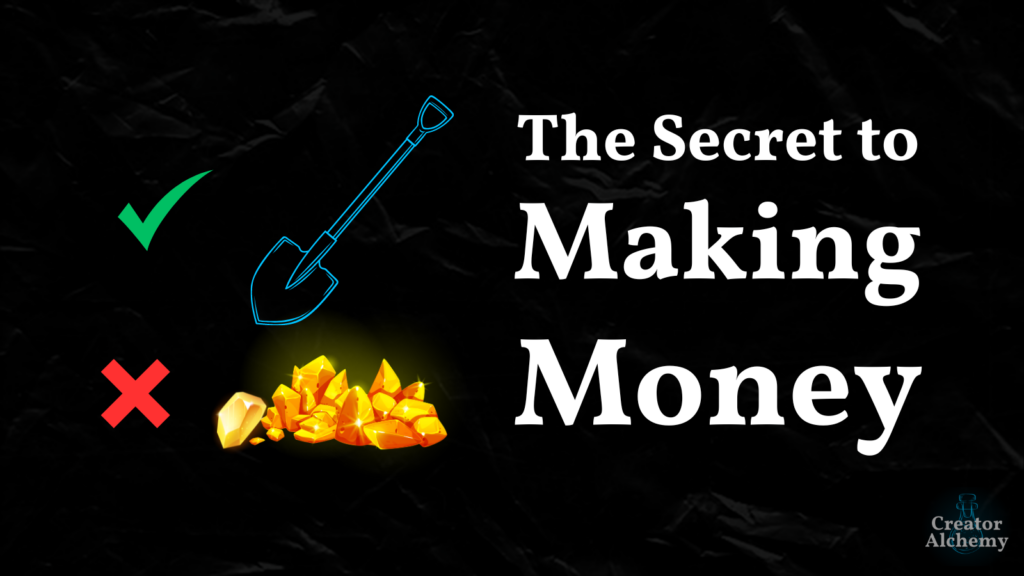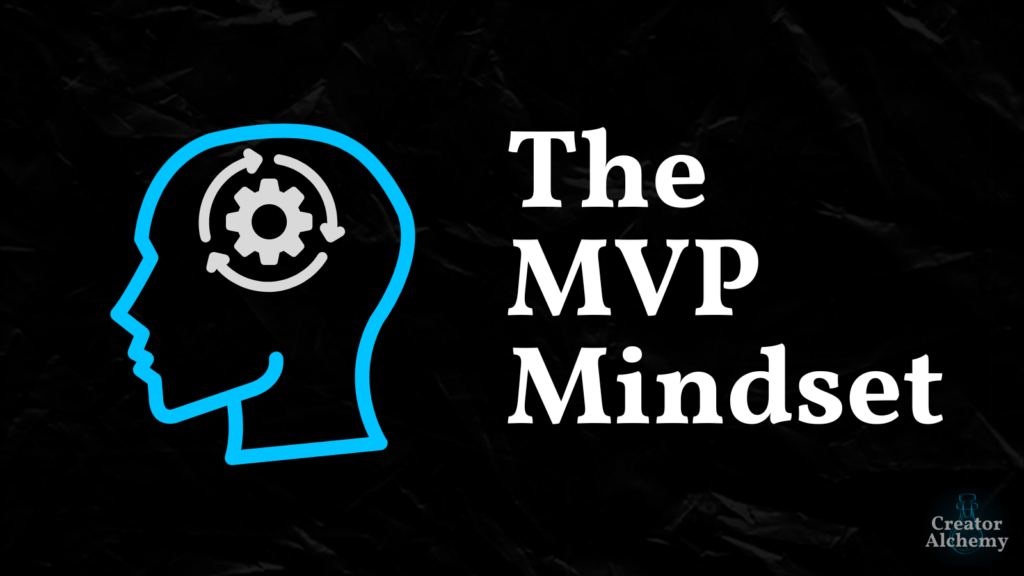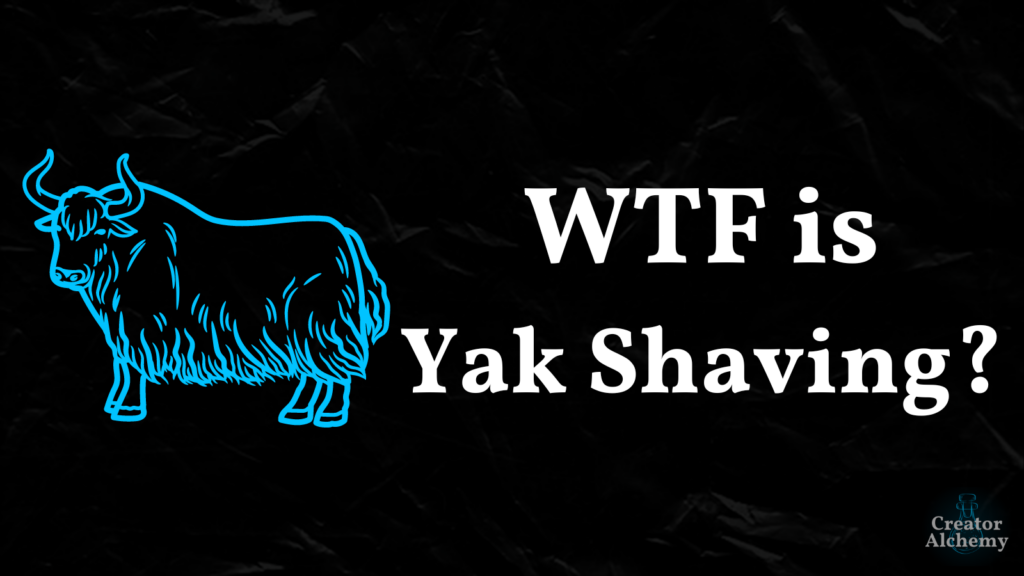Being a creator sounds amazing. You get to spend every day doing whatever you want? Complete control over your calendar? No boss? People pay you to just…be you, share what you’re excited about, and explore your creativity?
Sounds like a dream come true.
But how viable is the creator economy, actually?
Sure, there are those famous creators who make big bucks, but what about your average creator?
- How much do they make?
- How do they make it?
- How big of an audience does it take to make a livable income?
- What are the biggest barriers that keep creators from succeeding?
- How can creators overcome the dreaded algorithm?
- What really separates creators who succeed from those who struggle?
Well, thanks to research done by Kajabi, ConvertKit, and The Tilt, we have answers to all these and more.
Turns out, some creators are flourishing while many are floundering.
This is going to be a deep dive into their findings on the current state of the Creator Economy—I’ll share what they found and add my own interpretations to give you tactical tips and specific actions you can take to make sure your creator business succeeds.
If you’re a creator who wants to go full-time, or level up your creator business, here are 7 critical lessons you need to know…
•••
Lesson 1: Learn to Directly Monetize Your Audience
Most creators are overly reliant on 3rd part monetization strategies like AdSense revenue or brand deals.
Kajabi found that 69% (nice) of creators say they depend on brand deals, but brand deal money has been drying up, making it increasingly competitive to get and causing creators who depend on it to struggle. And though AdSense is one monetization route that makes YouTube appealing, Kajabi says 97.5% of YouTubers don’t make enough to reach the U.S. poverty line.
What does this mean for creators?
It means learning to rely on yourself and directly monetize your audience is critical to succeed as a creator and weather any economic turmoil.
When sponsorship or ad revenue money is coming in, that’s awesome. But you don’t control what cut you get. Your AdSense payout can get cut anytime. And company sponsorship budgets shrink all the time. But learning to create products and services your audience loves is much more in your control.
If you don’t create your own products and services, you’re just a glorified vacuum or makeup salesman—you don’t own anything you sell.
When I entered the Creator Economy, I had to monetize immediately. I’d gotten fired a month prior and didn’t have the luxury of a 6-month runway to figure things out.
I’ll go more in-depth with this in Lesson 3, but the shortest path to monetization for me (and many others) was coaching.
Coaching has a low barrier to entry and high margins. After I coached for a while and honed my systems, I productized them into a live course. After I ran multiple cohorts and further refined the strategies in it, I evolved it into a convenient self-paced course called Build an Intentional Life.
Build an Intentional Life is basically a self-paced coaching course where you get the exact same strategies I run all my 1:1 clients through to help them clarify what matters, overcome limiting beliefs, and build a life and business aligned with their values.
As people heard about some of the high-profile coaching clients I worked with, and saw how much people loved the live and self-paced courses based on my coaching frameworks, they wanted to know how to become a coach or level up their current coaching practice.
So I “sold my sawdust” and created a course about how I coach and productize my coaching systems called World-Class Coaching.
I specialize in helping creators reach their potential, so my audience is primarily creators. Creators struggle with clarifying what matters and overcoming limiting beliefs (which keep them from reaching their potential), but creators also want to find ways to stand out from their competition and monetize effectively—so many creators are also interested in learning how to coach.
So I have 3 rungs to my value ladder: 1:1 coaching, a course based on my coaching frameworks, and a behind-the-scenes course on how to build a coaching practice.
See the synergy?
Any creator can do this.
I don’t care about ad revenue and have never done a brand deal.
By focusing on promoting my own products and services, I stay in control and can focus on promoting my own stuff instead of panicking that a platform cut ad revenue share or a brand’s marketing budget shrank.
But most creators don’t even get to this point, because they haven’t cleared the first major hurdle of being a creator…
•••
Lesson 2: Hit $10K ASAP
Of the creators they surveyed, Kajabi found 42% made less than $10,000 last year, while ConvertKit found 55% made under $10,000.
So about half of everyone in the Creator Economy made less than $10,000 last year.
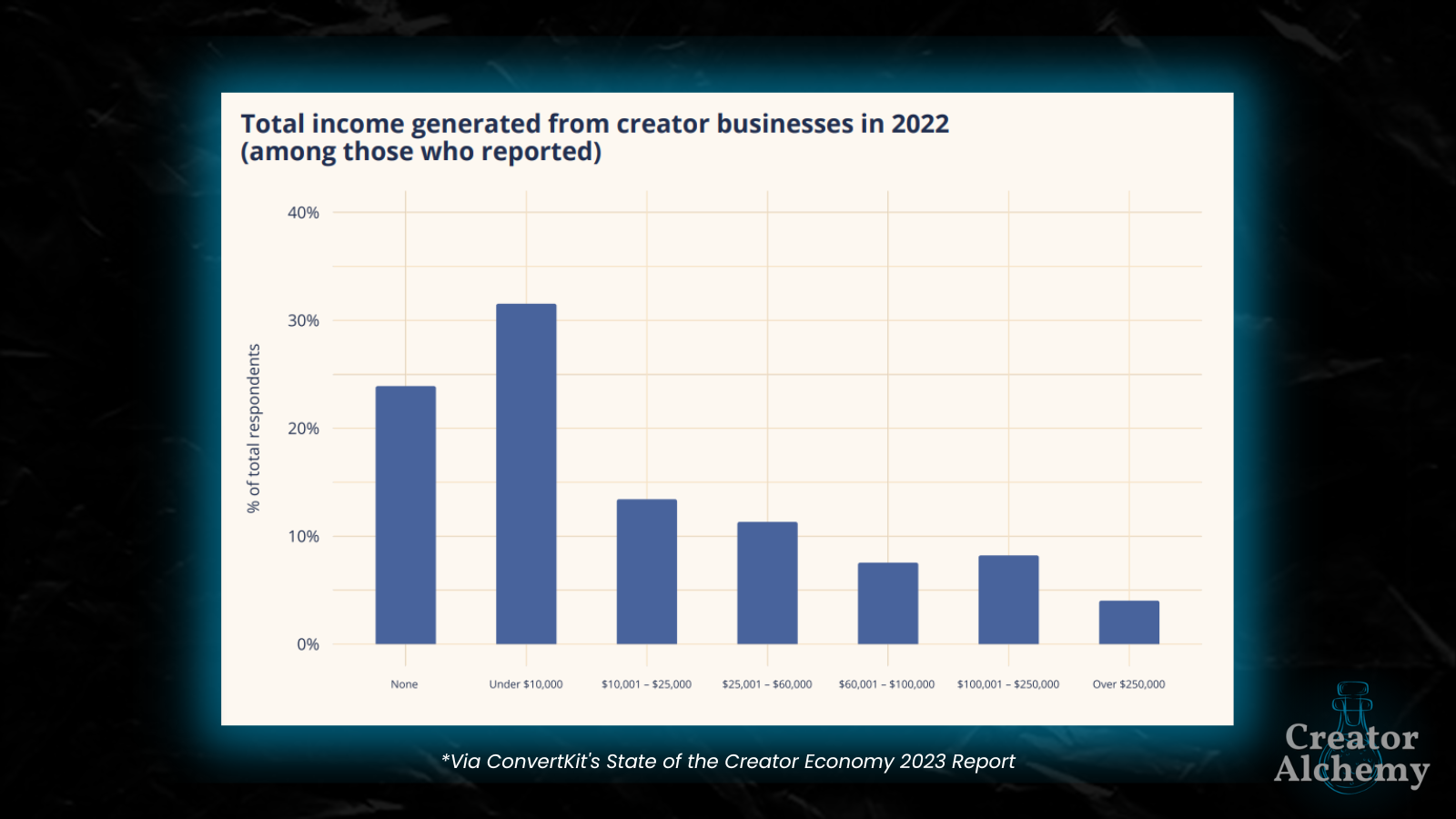
Which is nowhere near enough to go full-time.
Sounds depressing, right?
The Tilt found it takes creators roughly 5 months to earn their first dollar, 12 months to go full-time, and 18 months to make enough money to fully support themselves.
The Tilt also found most creators need about $10,000 in seed money to get their business off the ground.
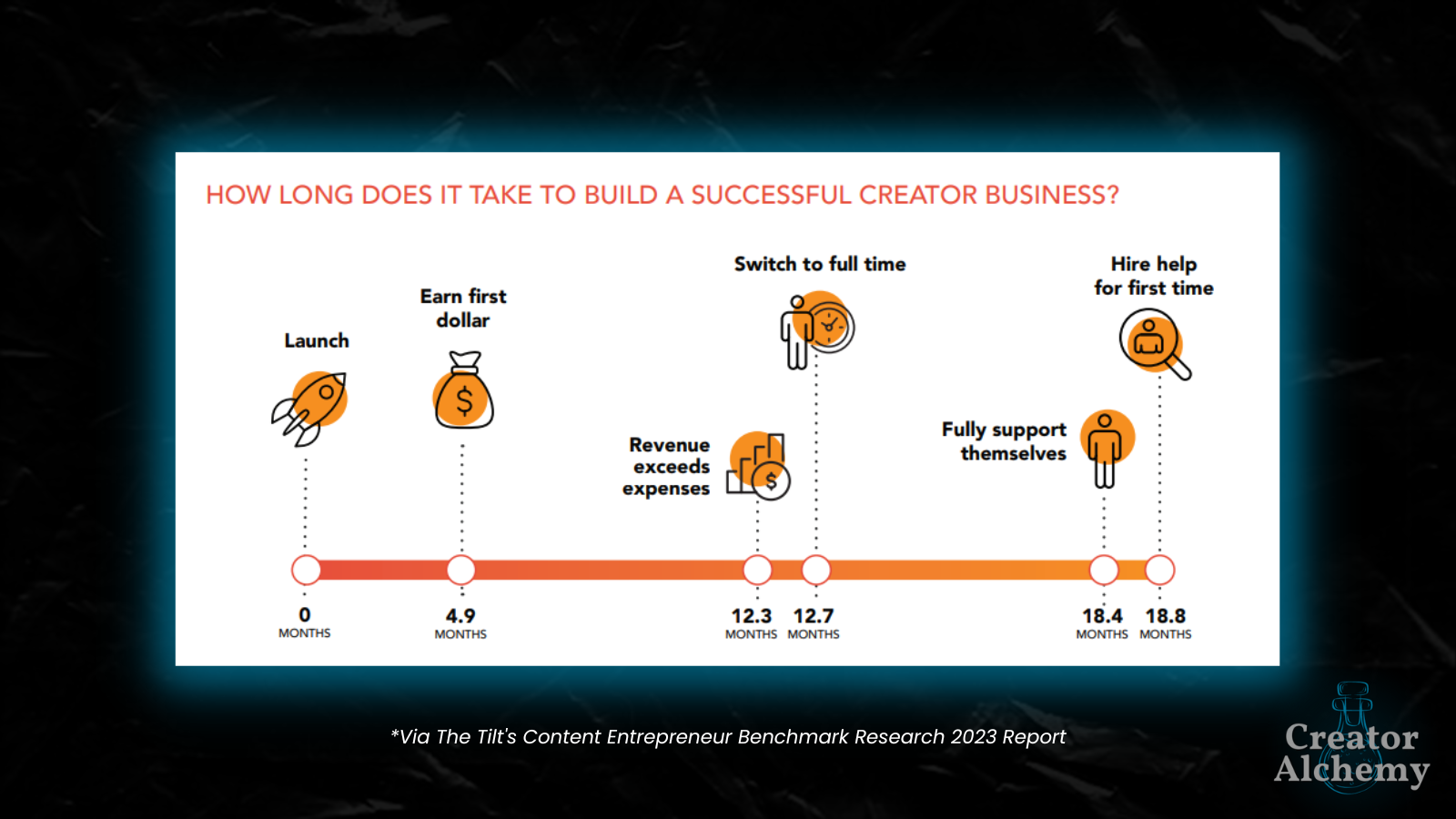
There’s that $10,000 number again…
But there’s good news.
The Tilt also found creators averaged $82,000 after 3 years and $104,000 after 6 years (ConvertKit found 20% of creators made over $60,000 and 12% made over $100,000).
What does this mean for creators?
Finding the shortest path to $10,000 is critical to success.
Hitting the $10,000 milestone helps validate your ideas are valuable, validates you’re on the right path, and gives you seed money to invest in your business.
Everything is downstream of that first $10,000.
But staring $10,000 in the face might seem impossible. But if you break it down, it feels way more achievable.
Here’s the simple math to hit $10,000 in 2 months:
- Coaching at $500/hour = 3 clients a month * 4 sessions each a month = $6,000 a month = $12,000 in 2 months
- An online course at $200 = 25 per month (less than 1 per day) = $10,000 in 2 months
- A paid newsletter at $100 per year = 100 subscribers (less than 2 per day)
Simple? Yes. Easy? No.
But once you break it down, your goal isn’t to hit $10,000—it’s to generate 1 sale per day, 2 subscriptions per day, or 1 client per week. Way more approachable.
Viability is one of the biggest hurdles to entering the Creator Economy.
So finding a way to make a viable income is your primary goal early on.
•••
Lesson 3: Start Coaching, Then Productize
Creators who offer coaching (and products related to coaching) are fairing much better than creators who don’t.
Kajabi found 40% of revenue from direct monetization came from online courses and 35% came from coaching.
The Tilt found coaching is the most profitable (and most popular at 49%) way to directly monetize.
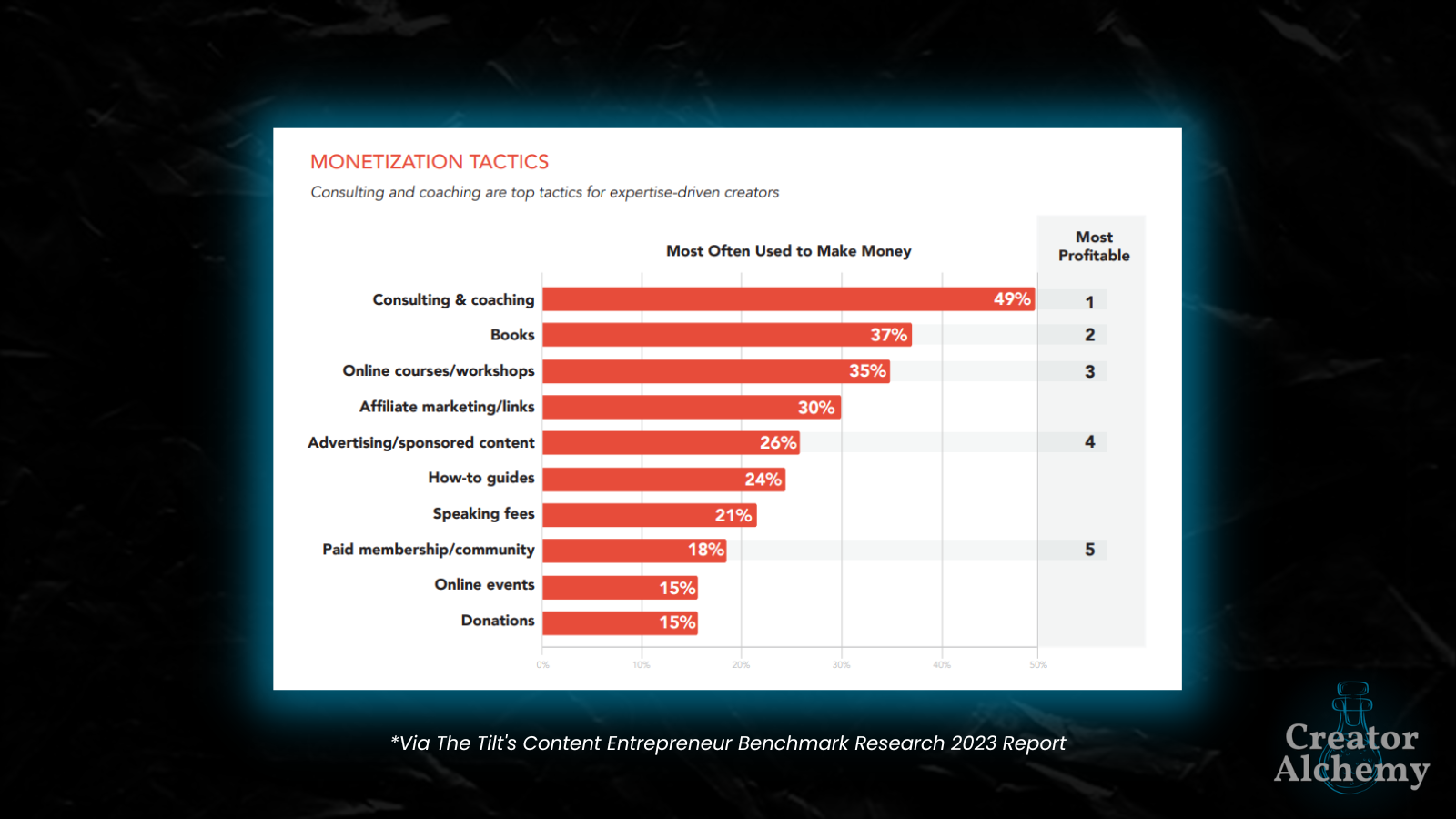
What does this mean for creators?
Start coaching people.
I go more in-depth with this point in 3 Huge Opportunities Creators Who Don’t Coach Are Missing Out On Right Now, but coaching is the single-best strategy creators, especially early creators looking to validate their ideas, build an audience, and generate a livable income, should do.
In the 3 years I’ve been in the Creator Economy, I’ve seen countless people dip their toes into being a creator, struggle to get attention or monetize, then give up in a few months.
But the creators who offer a direct service like coaching? Most are still in the game, and many are absolutely crushing it.
Coaching subsidizes your learning.
Here’s what I mean…
- Your ideal client pays you to learn how to help them better.
- You take these insights and create content targeted to people like them.
- You continue to refine your 1:1 coaching strategies, generating more testimonials and better content.
- You productize your coaching frameworks into courses and other digital products.
- Your free content attracts more people like your ideal clients, so they buy your courses and hire you to coach them.
And you keep repeating this cycle of coach, learn, share valuable content, attract true fans who buy, repeat.
This is the beauty of a value ladder.
Now you have a high-priced coaching offer and a lower-priced course. People who can’t afford coaching can take the course. Some people who take the course will want to work with you 1:1. As demand for coaching increases, you can charge more because there’s more demand, you’ve gotten better and have results to prove it, and you have a course to downsell people on.
If you want a full breakdown of this process, including fundamental coaching skills, how to get your first clients, create value ladders, generate inbound leads, attract life-changing opportunities, and start charging $500+ an hour, check out World-Class Coaching. It’s a self-paced course with everything you need to know and do to get started coaching, or level up your current coaching practice.
I know I sound like a broken record, but coaching is a phenomenal first step toward viability as a creator—both because it helps you make money faster and helps you develop valuable, unique content that attracts True Fans and ideal clients.
Because not all audiences are created equal…
•••
Lesson 4: Build a Deep Audience Over a Big Audience (Why Less is More)
You don’t have to have a million followers to succeed in the Creator Economy. In fact, 99% of creators have way less than a million followers.
Kajabi found 61% of creators had under 10,000 followers across platforms (26% had under 1,000 and 35% had between 1,000-9,999).
The Tilt found the median number of followers is 4,000.
What does this mean for creators?
Focus on who follows you, not how many follow you.
Follower count is largely a vanity metric, especially if you don’t have a monetization strategy.
I know plenty of accounts with 70,000-500,000 followers who can’t monetize their audience. Because they built their following by posting platitudes and roundups of the “best X every Y should know about,” and wonder why their massive audience is lukewarm and uninterested in buying.
The Tilt also found most creators use 4 channels on average, but only 2 of these generate revenue.
I’ve seen this, too. Most of my revenue comes from my newsletter and Twitter. I’ve tried other social media platforms, but haven’t seen enough engagement to make them worth my time.
So by focusing on fewer platforms (that you actually enjoy using), attracting the right people, and deeply connecting with them (it’s called social media), you can make a solid income from a small audience.
If you want a deep dive into strategies to help you create content your ideal audience loves, check out this article.
But 4,000 followers aren’t created equal, which brings me to my next point…
•••
Lesson 5: You Need a Newsletter
If I could spread out an audience of 4,000 across platforms, I’d concentrate them all in a newsletter. Not Twitter, TikTok, Instagram, LinkedIn, or even YouTube.
If you’ve built a large audience on a social media platform, you’re one algorithm change away from having no reach, no audience, and no way to recover.
Kajabi found 77% of creators said algorithm changed had a moderate-to-significant impact on their audience engagement. They also found that, due to algorithm changes, 25% of creators estimate they’ve lost $1000-$9,999 and 24% estimate they’ve lost $10,000-$49,999.
So the algo can steal $50,000 out of your pocket without warning or recompense.
What does this mean for creators?
You need a newsletter.
If you have a newsletter, you own your distribution. Meaning if you have 1,000 subscribers and send an email, all 1,000 will get it.
If you have 1,000 Twitter/IG/whatever followers and post something, maybe 100 will see it. But I’m increasingly seeing accounts with over 100,000 followers getting a couple hundred impressions total.
Newsletters also allow you to develop a deeper relationship with your audience and dive deeper into topics. Social media isn’t known for nuance, but newsletters are.
Social media is great to raise awareness for your content, but move people from social media to your newsletter ASAP so you’re not beholden to the algo.
My main CTA for all my content (unless I’m doing a launch) is always to subscribe to my newsletter.
ConvertKit found 54% of creators have a newsletter. If you’re in the 46% who don’t, do yourself and your audience a favor and start one.
Here’s a layer deeper into why this is so important…
•••
Lesson 6: Think Like an Entrepreneur
Something no one prepares you for when you enter the Creator Economy is that most successful creators spend the majority of their time not creating.
The Tilt found creators spend 54% of their time on tasks other than creating.
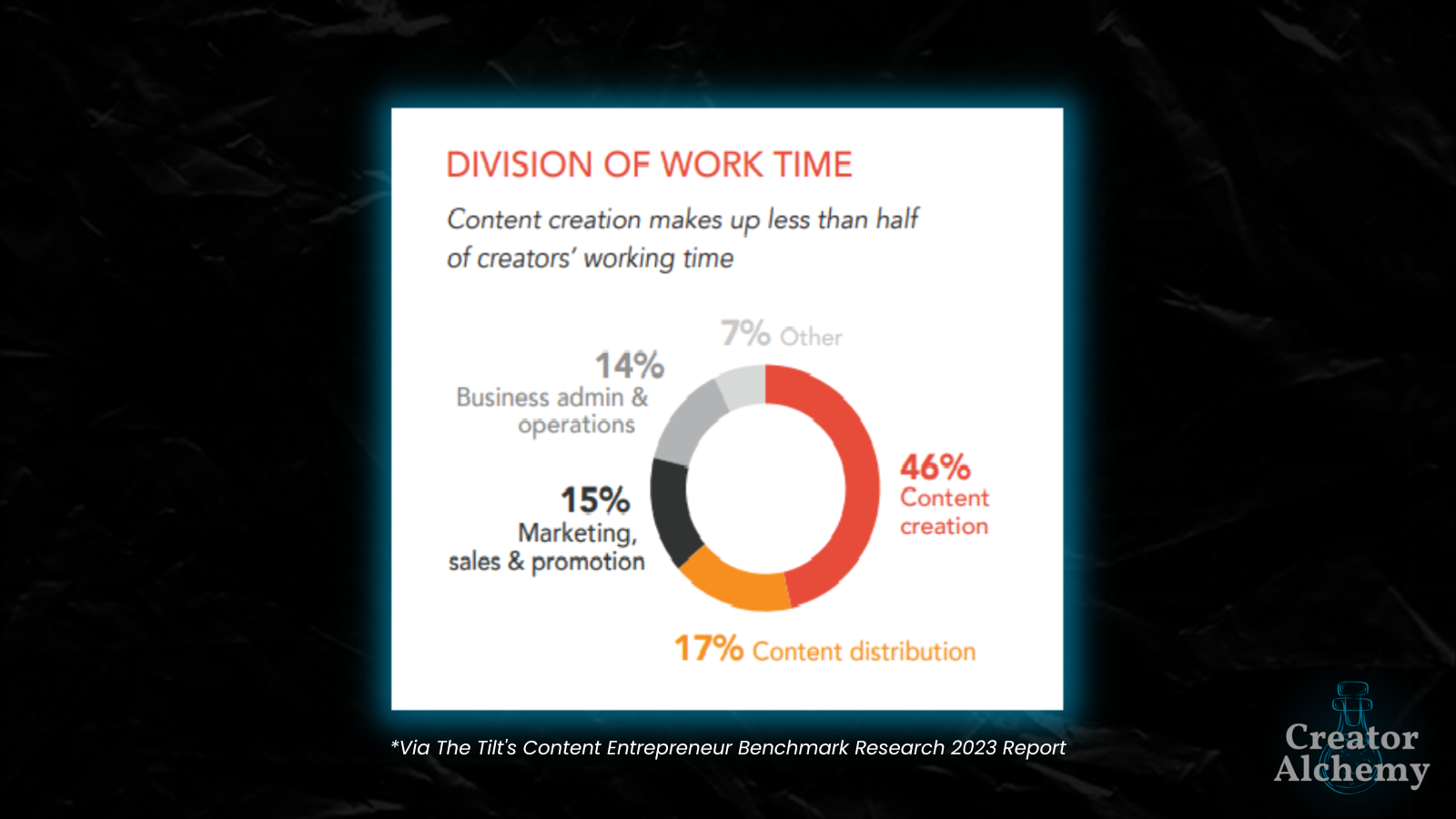
What does this mean for creators?
Most creators struggle to succeed (aka, make a living) from their content because they treat it like a hobby. There’s nothing wrong with having a hobby.
But it’s called the Creator Economy, not the Creator Hobby-For-Funsies-Playtime-Jamboree.
If you want to succeed in the Creator Economy, you need to develop an entrepreneurial mindset.
Don’t expect a hobby work ethic to lead to commercial success.
An entrepreneurial mindset basically boils down to identifying a problem and providing a solution:
- Who do you want to help?
- What do they need help with?
- How can you solve this for them?
- Where do they hang out so you can get your solution in front of them?
Everything else is downstream of clarifying these questions.
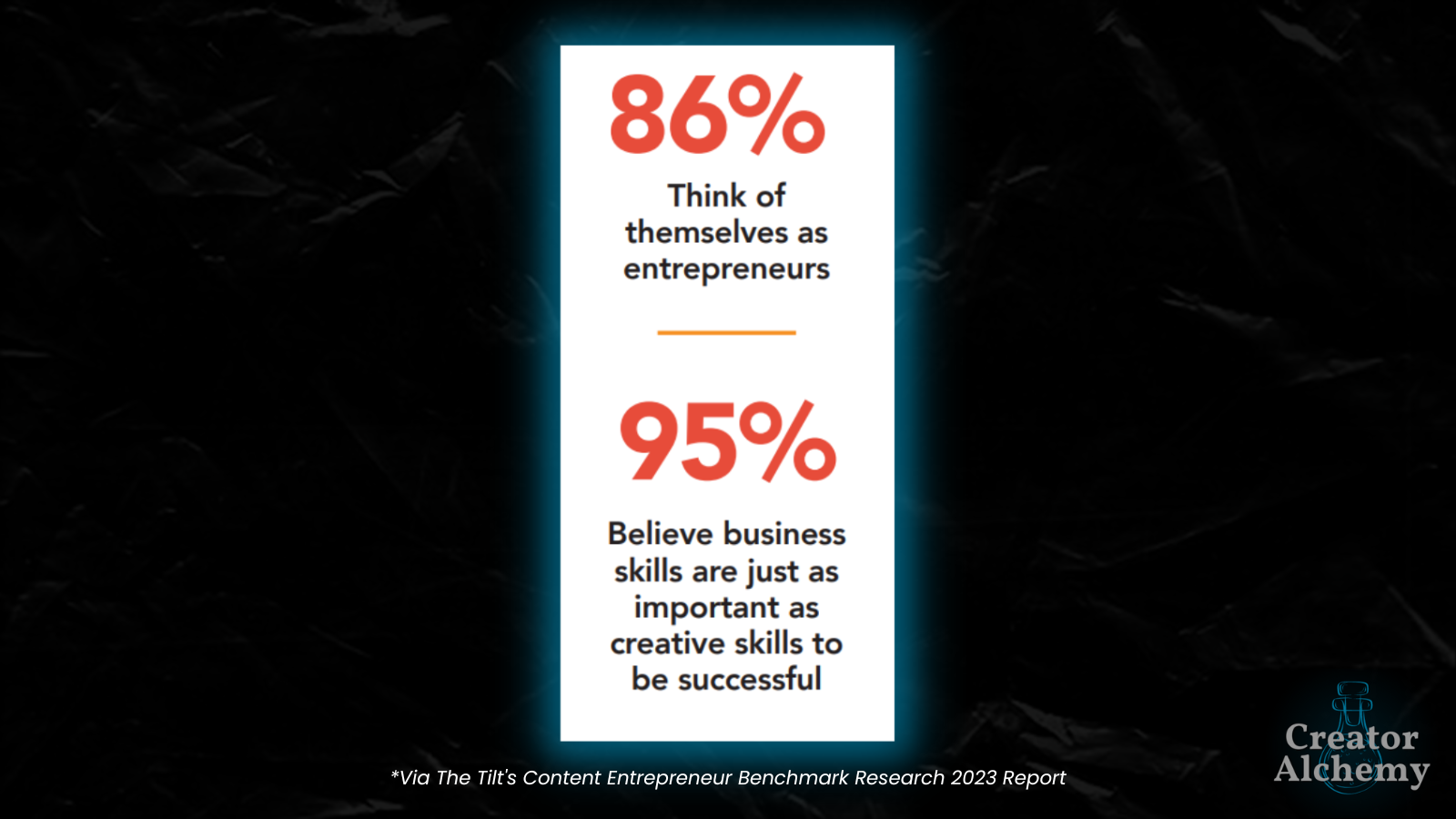
Treating yourself and your work like a business also means investing in yourself and your business.
ConvertKit found 47% spend $500 or more per month on their creator business, and The Tilt found creators spend $10,700 on average to start their business.
But don’t fret, there are tons of ways to mitigate these expenses early on. Check out this article on how to de-risk and de-stress your creator business.
Your biggest expenses tend to be software and courses, so choosing ones you actually need and have the highest ROI is key.
I’ve tried tons of platforms and taken loads of courses, and here’s what I currently recommend (some are affiliate links)…
The backbone of my creator business:
- Kajabi—course hosting, landing pages, coaching CRM, + tons more.
- ConvertKit—newsletter and email marketing.
- Notion—drafting content ideas and all-around second brainery.
- Spotify—I need bitchin’ tunes to focus. I legitimately couldn’t stay on task with music.
Courses that’ve been instrumental in helping me succeed as a creator:
- Write of Passage—Learn how to write for an online audience.
- Part-Time YouTuber Academy—Everything you need to start, grow, and monetize a YouTube channel.
- 2-Hour Writer—Build a personal brand, develop a content ecosystem, and monetize your audience.
- Thinking in Stories—Level up your storytelling and learn the strategies behind what makes one of the best modern writers, Lawrence Yeo’s, articles so compelling.
Creators who succeed invest in themselves and their business, and approach their content with an entrepreneurial mindset.
If you want to succeed, embrace being an entrepreneur who creates content and you’ll do well.
•••
Lesson 7: Conquer the Mental Game
Succeeding in the Creator Economy comes down to finding ways to stay in the game long enough to gain traction.
Beyond the financial viability strategies, the other biggest obstacle creators struggle with is the mental side.
Of all the barriers to launching a creator business, the Tilt found most boil down to human psychology.
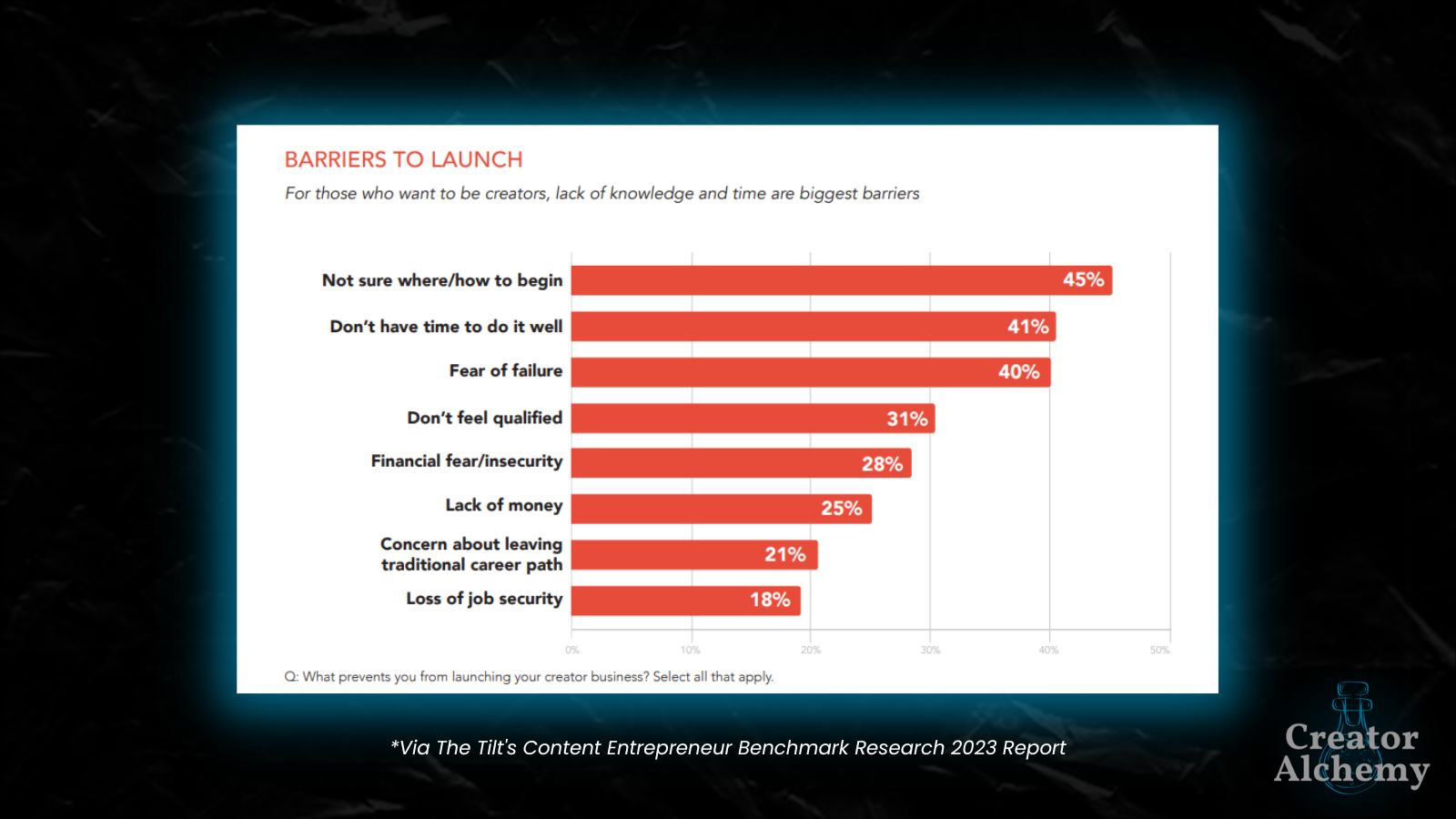
What does this mean for creators?
Lack of money, resources, or intelligence isn’t what holds most creators back.
Limiting beliefs are—especially the Four Horsemen of Fear.
Imposter Syndrome, FOMO, Shiny Object Syndrome, uncertainty, insecurity, and so many other things that prevent creators from putting themselves and their ideas out into the world revolve around the Four Horsemen of Fear.
So finding strategies to overcome these fears is critical to success.
But even after you manage to overcome these fears, many creators struggle with another psychological barrier—burnout.
ConvertKit found 47% of creators experienced burnout last year, but that’s a decrease of 14% since their previous report. They found burnout was highest for part-time creators, probably because they had to juggle a job and their creator business (another reason to find a way to go full-time ASAP).
The biggest reasons for creator burnout tend to revolve around a sense of obligation to “feed the machine” and be everywhere all the time.
But remember how most creators average 4 channels, but only 2 generate meaningful revenue?
When I was on a bunch of platforms, especially whose formats I’m not keen on, I started to feel burnout creeping in.
Here are a few constraints that’ve helped me avoid burnout and continue to be energized by my creator business:
- Pick 1 primary platform (Twitter, for me)
- Pick 1 “main” thing (my newsletter)
- Set healthy boundaries (I work until 4 or 6)
- Use social media to be social, not spout platitudes from on-high
- Surround yourself with inspiration (books, podcasts, etc.)
- Hang out with other creators
- Explore your creativity (build new courses, articles, bigger projects, etc.)
Remember, you’ll spend most of your time not creating.
But you’re a creator, and you got into this because you love creating.
So it’s critical you actually enjoy creating when you get the opportunity to do it.
If creating feels like a grind, and the admin side of your business also feels like a grind, you’ll burn out fast.
Find ways to rest, reset, and reenergize so you can fully show up every day.
•••
Final Thoughts
Being a creator is hard and full of uncertainty.
But despite these issues, more people are joining the Creator Economy every day.
Why?
Because creators value freedom. They seek autonomy, authenticity, and adventure—and building a creator business is the best strategy to pursue this path.
But it’s easy to fall into the trap of comparing yourself to creators a few steps ahead of you who are killing it.
The Tilt found full-time creators earned approximately $86,000 in 2022 and expect to generate $108,199 in 2023.
But they also found that 59% of creators have been in business fewer than 4 years.
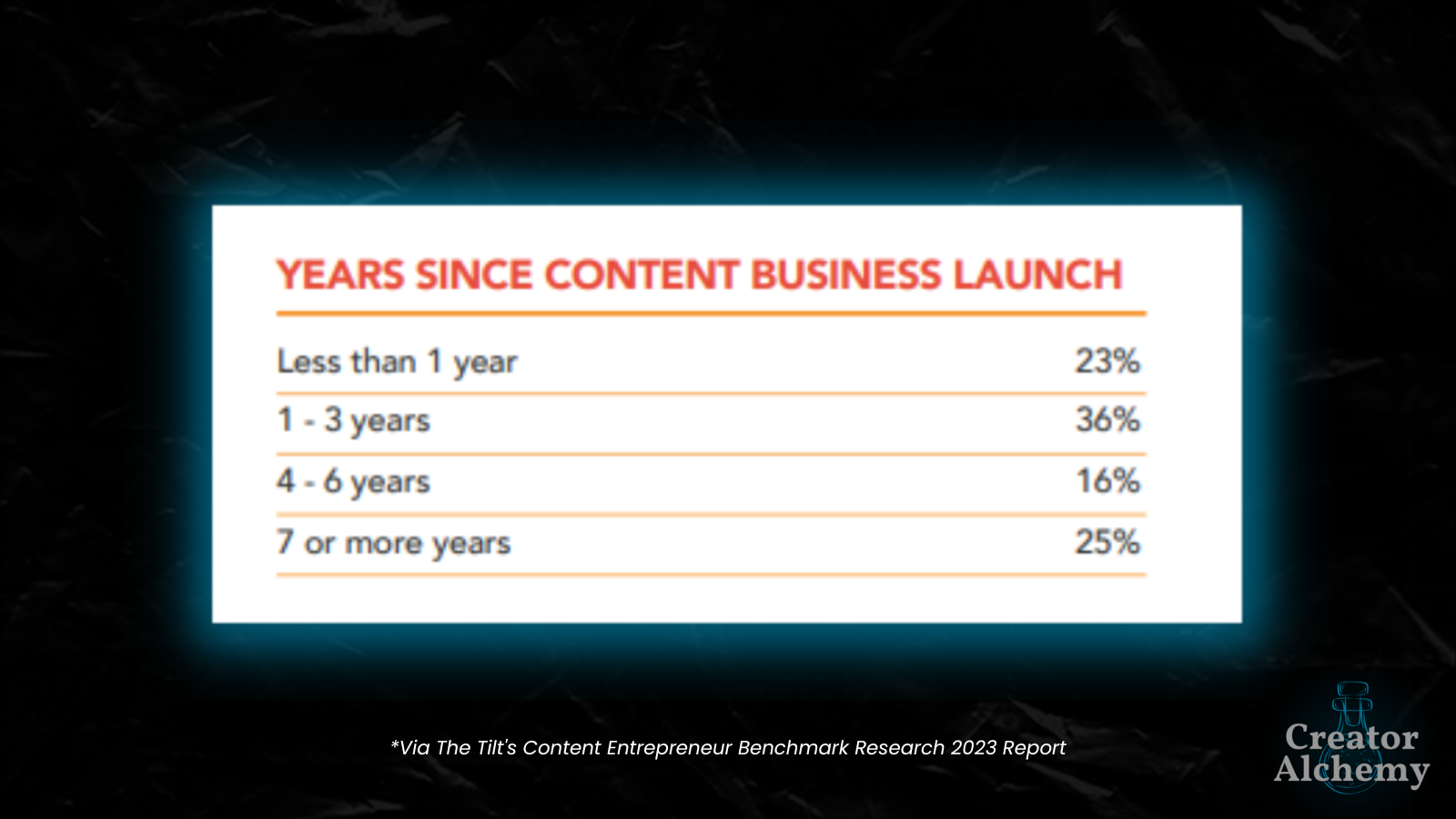
So if you’re 1-3 years in, don’t compare yourself to creators 5-7 years in.
See them as inspiration—as proof this creator thing is viable.
This is why so many creators are optimistic about their creator business and income potential.
ConvertKit found that, despite economic turmoil and layoffs in traditional sectors, almost 80% of creators expect to make more from their creator business this year than last year.
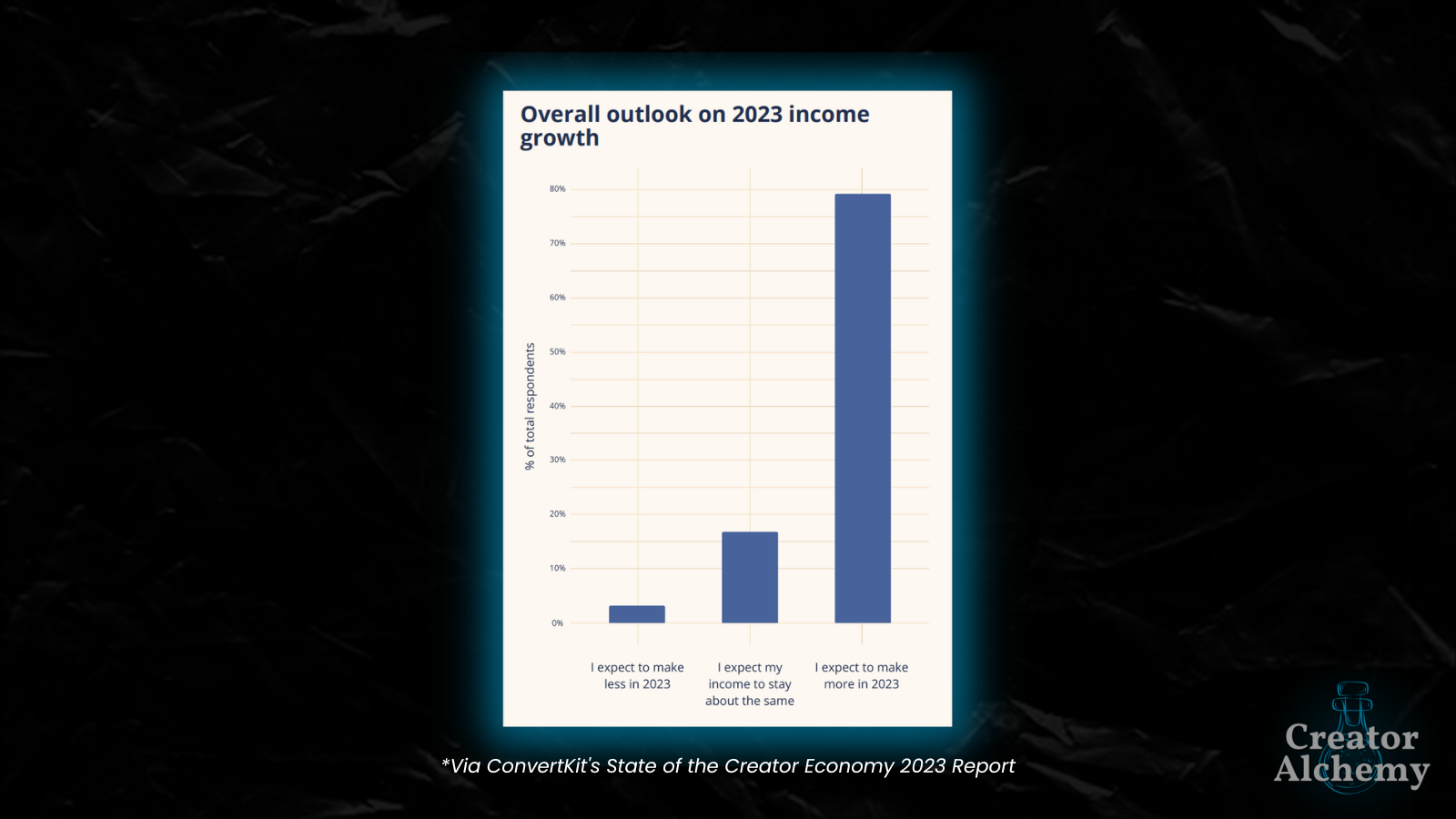
Some creator niches feel even more confident about their business this year—with 95% of coaches expecting to make more money this year.
Why?
Because although being a creator, like any type of entrepreneurship, is full of uncertainty—unlike most jobs, the better you get, the better you’re rewarded.
At my old job, it didn’t matter how great I got at helping people or how many people I helped—I got paid the same as the person who sucked at their job but did just enough to avoid getting fired.
As a creator, the more you learn and iterate, the better you get and the more people you help, the more impact and income you generate.
This is why creators, especially creators who focus on directly monetizing their audience through coaching or digital products, are so optimistic about their impact and income potential.
Because we know our success tomorrow depends on our work ethic today.
But more importantly, creators overall love their work.
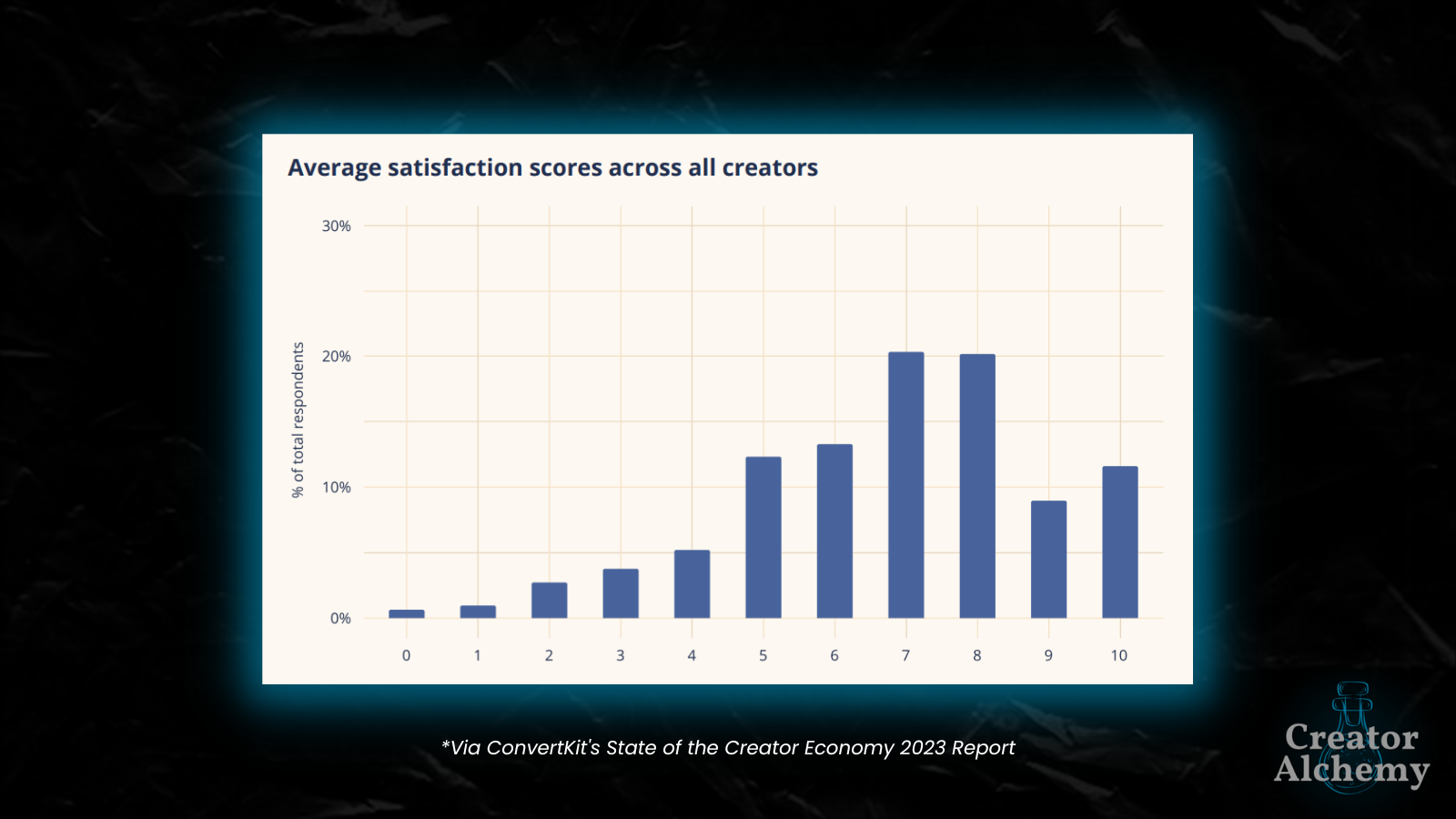
Few people can honestly say they love the work they do.
But we can.
This is why so many people are joining the Creator Economy.
But the uncertainty and inability to make money is what causes so many people to leave the Creator Economy.
So finding strategies to generate a livable income, attract the right audience, build a deep connection, overcome your own fears, prevent burnout, and remember why you do what you do are critical to succeeding as a creator.
I hope this (long) article gave you some solid tactics, strategies, and concepts to thrive in the Creator Economy, because I legitimately want you to succeed—and major thanks to Kajabi, ConvertKit, and The Tilt for doing all this research.
Happy creating…

